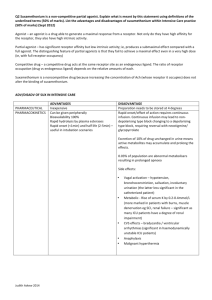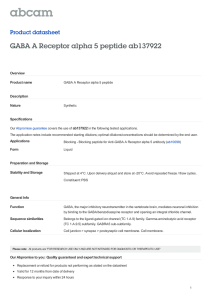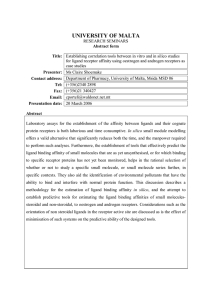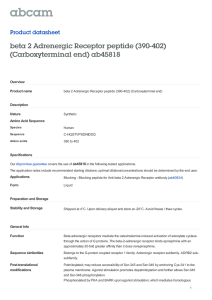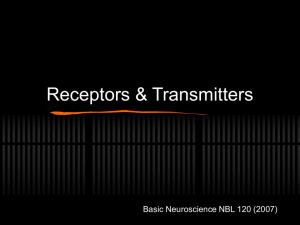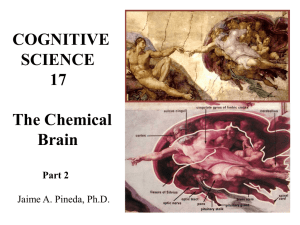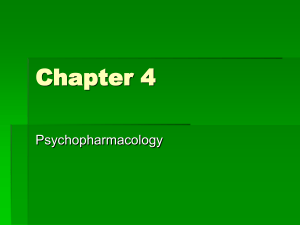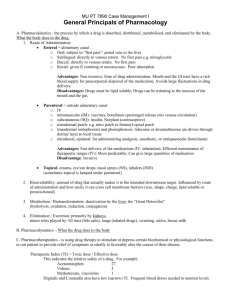news and views
advertisement
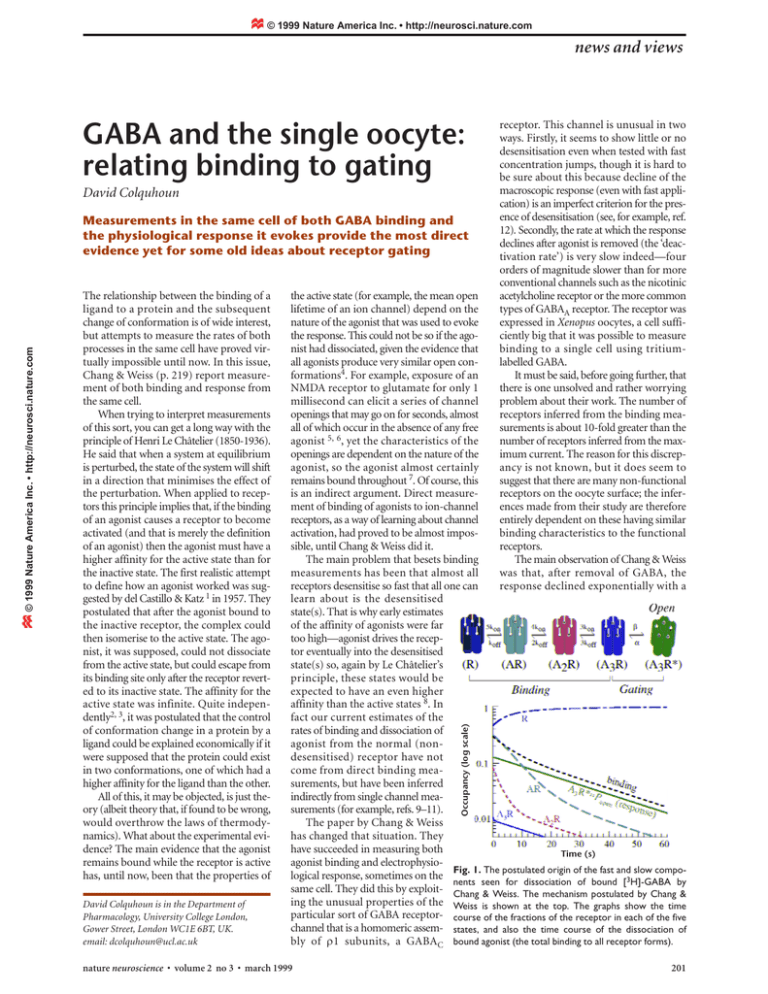
© 1999 Nature America Inc. • http://neurosci.nature.com news and views GABA and the single oocyte: relating binding to gating David Colquhoun The relationship between the binding of a ligand to a protein and the subsequent change of conformation is of wide interest, but attempts to measure the rates of both processes in the same cell have proved virtually impossible until now. In this issue, Chang & Weiss (p. 219) report measurement of both binding and response from the same cell. When trying to interpret measurements of this sort, you can get a long way with the principle of Henri Le Châtelier (1850-1936). He said that when a system at equilibrium is perturbed, the state of the system will shift in a direction that minimises the effect of the perturbation. When applied to receptors this principle implies that, if the binding of an agonist causes a receptor to become activated (and that is merely the definition of an agonist) then the agonist must have a higher affinity for the active state than for the inactive state. The first realistic attempt to define how an agonist worked was suggested by del Castillo & Katz 1 in 1957. They postulated that after the agonist bound to the inactive receptor, the complex could then isomerise to the active state. The agonist, it was supposed, could not dissociate from the active state, but could escape from its binding site only after the receptor reverted to its inactive state. The affinity for the active state was infinite. Quite independently2, 3, it was postulated that the control of conformation change in a protein by a ligand could be explained economically if it were supposed that the protein could exist in two conformations, one of which had a higher affinity for the ligand than the other. All of this, it may be objected, is just theory (albeit theory that, if found to be wrong, would overthrow the laws of thermodynamics). What about the experimental evidence? The main evidence that the agonist remains bound while the receptor is active has, until now, been that the properties of David Colquhoun is in the Department of Pharmacology, University College London, Gower Street, London WC1E 6BT, UK. email: dcolquhoun@ucl.ac.uk the active state (for example, the mean open lifetime of an ion channel) depend on the nature of the agonist that was used to evoke the response. This could not be so if the agonist had dissociated, given the evidence that all agonists produce very similar open conformations4. For example, exposure of an NMDA receptor to glutamate for only 1 millisecond can elicit a series of channel openings that may go on for seconds, almost all of which occur in the absence of any free agonist 5, 6, yet the characteristics of the openings are dependent on the nature of the agonist, so the agonist almost certainly remains bound throughout 7. Of course, this is an indirect argument. Direct measurement of binding of agonists to ion-channel receptors, as a way of learning about channel activation, had proved to be almost impossible, until Chang & Weiss did it. The main problem that besets binding measurements has been that almost all receptors desensitise so fast that all one can learn about is the desensitised state(s). That is why early estimates of the affinity of agonists were far too high—agonist drives the receptor eventually into the desensitised state(s) so, again by Le Châtelier’s principle, these states would be expected to have an even higher affinity than the active states 8. In fact our current estimates of the rates of binding and dissociation of agonist from the normal (nondesensitised) receptor have not come from direct binding measurements, but have been inferred indirectly from single channel measurements (for example, refs. 9–11). The paper by Chang & Weiss has changed that situation. They have succeeded in measuring both Time (s) agonist binding and electrophysiological response, sometimes on the Fig. 1. The postulated origin of the fast and3 slow components seen for dissociation of bound [ H]-GABA by same cell. They did this by exploit- Chang & Weiss. The mechanism postulated by Chang & ing the unusual properties of the Weiss is shown at the top. The graphs show the time particular sort of GABA receptor- course of the fractions of the receptor in each of the five channel that is a homomeric assem- states, and also the time course of the dissociation of bly of ρ1 subunits, a GABAC bound agonist (the total binding to all receptor forms). nature neuroscience • volume 2 no 3 • march 1999 Occupancy (log scale) © 1999 Nature America Inc. • http://neurosci.nature.com Measurements in the same cell of both GABA binding and the physiological response it evokes provide the most direct evidence yet for some old ideas about receptor gating receptor. This channel is unusual in two ways. Firstly, it seems to show little or no desensitisation even when tested with fast concentration jumps, though it is hard to be sure about this because decline of the macroscopic response (even with fast application) is an imperfect criterion for the presence of desensitisation (see, for example, ref. 12). Secondly, the rate at which the response declines after agonist is removed (the ‘deactivation rate’) is very slow indeed—four orders of magnitude slower than for more conventional channels such as the nicotinic acetylcholine receptor or the more common types of GABAA receptor. The receptor was expressed in Xenopus oocytes, a cell sufficiently big that it was possible to measure binding to a single cell using tritiumlabelled GABA. It must be said, before going further, that there is one unsolved and rather worrying problem about their work. The number of receptors inferred from the binding measurements is about 10-fold greater than the number of receptors inferred from the maximum current. The reason for this discrepancy is not known, but it does seem to suggest that there are many non-functional receptors on the oocyte surface; the inferences made from their study are therefore entirely dependent on these having similar binding characteristics to the functional receptors. The main observation of Chang & Weiss was that, after removal of GABA, the response declined exponentially with a 201 © 1999 Nature America Inc. • http://neurosci.nature.com © 1999 Nature America Inc. • http://neurosci.nature.com news and views deactivation time constant of about 25 seconds, but [3H]-GABA dissociated with a time course that could be fitted with two exponential components, with time constants of about 6 seconds and 29 seconds, the slower component being similar to the deactivation time constant in the same cell. Furthermore, the two time constants for dissociation were more or less independent of the concentration of GABA with which the cells were equilibrated initially, but the relative amplitude of the slow component increased with this GABA concentration, and that of the fast component decreased. This is, roughly speaking, what might be expected if the fast component represented dissociation from channels that were already shut at the time that GABA was removed (and did not subsequently open), and the slow component represented dissociation of GABA molecules that were bound to open channels. But before coming to any such conclusion, two things must be done. Firstly, we must be sure that the observed rates are not limited by diffusion. The oocyte is so big that it has an essentially planar unstirred layer, which would limit the rate of change of concentration at the surface to around 1 second or so, even without the vitelline membrane. This should be fast enough to allow approximate measurement of the 5- and 25-second time constants that were observed, unless further slowing were caused by binding to receptors on the invaginated surface of the oocyte. Chang & Weiss adduce several convincing lines of evidence that their rates are not diffusion-limited. For example, two mutants that showed slower and fast deactivation than the wildtype receptor also showed parallel changes in dissociation rate. And when cooling increased the deactivation time constant to over 300 seconds, the slow component of dissociation was similarly slowed. Secondly, we must remember that the observed time constants are actually functions of all the rate constants for transitions between receptor states, and cannot in general be given a simple physical interpretation. Furthermore, not much can be inferred from the observation that binding and response share common values for time constant(s), since this outcome is predicted by any Markovian mechanism whatsoever. To arrive at any firm conclusion about a physical quantity (such as a microscopic dissociation rate constant) we must have a physically realistic reaction mechanism 4. No such mechanism has been determined for GABAC receptors, so Chang & Weiss use the simplest possible five-state model (three bindings followed by opening) to interpret their results (Fig. 1). Their 202 inferences are dependent on this model being sufficiently close to physical reality. Having five states, the model predicts that the time course of both binding and response will be described by four exponential components, with the same time constants for both, though for a jump to zero concentration some of them will have zero amplitudes 13. By appropriate choice of rate constants for transitions between states, it was possible to mimic the observed time constants, and to show that only one (for deactivation) or two (for dissociation of binding) of the four components would be expected to have an amplitude large enough for it to be observable. Chang & Weiss postulated (Fig. 1) that three sequential bindings of GABA molecules to the receptor are followed by isomerisation to the open state (though the receptor probably has five binding sites). The rate constants given in their Table 3 were used to calculate the time course of each of the five states, and hence the binding occupancy 14 and burst characteristics 15 were calculated. The calculation refers to a jump to zero concentration at t = 0, after equilibration with 0.25 µM GABA (as in the antepenultimate line of Table 3 in Chang & Weiss). The time constants for dissociation of bound GABA are 5.55 seconds and 26.4 seconds (the other two dissociation components have zero or negligible amplitude, so their time constants would not be expected to be measurable). The time constants for the decline of the response (‘deactivation’) are, of course, identical, but only the 26.4-second component has detectable amplitude. The physical interpretation of the macroscopic rates is made clear by these calculations. The slow component is essentially identical with the mean length of a channel activation, which at zero GABA concentration consists of oscillations between the two fully-liganded states (see ref. 6). On average there are predicted to be 7.67 openings, each 3.22 seconds long, separated by shut times of mean length 0.24 seconds, giving a mean activation (‘burst’) length of 26.4 seconds, throughout which the receptor is fully occupied. The origin of the fast component (according to the postulated mechanism) is also clear from Fig. 1. At t = 0, the most prevalent occupied state is seen to be the singly-liganded state (AR). The mean lifetime of this state (at zero GABA concentration) is 5.55 seconds (virtually identical with the faster time constant), so the fast component consists essentially of dissociation of agonist from the singly occupied receptor (which cannot re-open at zero agonist concentration). In this example there is little contribution from the doubly (A2R), or triply occupied (A3R) forms, simply because there is not much of either form present at t = 0. The prediction of the relative amplitudes of the components of dissociation is not very accurate, perhaps because the postulated mechanism is too simple. Nevertheless the qualitative agreement is sufficient to suggest that the slow component of dissociation does indeed, to a good approximation, arise from [3H]-GABA that was bound to triply occupied channels, which are open for most of the time. It would be very nice if the method of Chang & Weiss could be applied to other sorts of receptors too. Unfortunately most other receptors activate (and often desensitise) much too rapidly for the rate of binding to be measured by their method, though it should be possible to investigate at least the slower components of desensitisation in this way. So, what have we learned from this study? It cannot really be said that it leads to any new insight. What it does instead is to confirm, by direct observation, that the ideas about how agonists work that we have assumed to be reasonable ever since the 1950s, are indeed roughly right. It is very nice to know that this is so, and that thermodynamics is safe. 1. del Castillo, J. & Katz, B. Proc. R. Soc. Lond. B 146, 369–381 (1957). 2. Wyman, J. & Allen, D.W. J. Polymer Sci. VII, 499–518 (1951). 3. Monod, J., Wyman, J. & Changeux, J.P. J. Mol. Biol. 12, 88–118 (1965). 4. Colquhoun, D. Br. J. Pharmacol. 125, 923–948 (1998). 5. Lester, R.A.J., Clements, J.D., Westbrook, G.L. & Jahr, C.E. Nature 346, 565–567 (1990). 6. Wyllie, D.J.A., Béhé, P. & Colquhoun, D. J. Physiol .(Lond.) 510, 1–18 (1998). 7. Béhé, P., Colquhoun, D. & Wyllie, D.J.A. in Ionotropic glutamate receptors in the CNS (eds. Jonas, P. & Monyer, H.) (Springer, Berlin, 1999, in press). 8. Heidmann, T., Bernhardt, J., Neumann, E. & Changeux, J.-P. Biochemistry 22, 5452–5459 (1983). 9. Colquhoun, D. & Sakmann, B. J. Physiol.(Lond.) 369, 501–557 (1985). 10. Sine, S.M., Claudio, T. & Sigworth, F.J. J. Gen. Physiol. 96, 395–437 (1990). 11. Maconochie, D.J. & Steinbach, J.H. J. Physiol. (Lond.) 506, 53–72 (1998). 12. Feltz, A. & Trautmann, A. J. Physiol. (Lond.) 322, 257–272 (1982). 13. Colquhoun, D., Hawkes, A.G., Merlushkin, A. & Edmonds, B. Phil. Trans. R. Soc. Lond. A 355, 1743–1786 (1997). 14. Colquhoun, D. & Hawkes, A.G. Proc. R. Soc. Lond. B 199, 231–262 (1977). 15. Colquhoun, D. & Hawkes, A.G. Phil. Trans. R. Soc. Lond. B 300, 1–59 (1982). nature neuroscience • volume 2 no 3 • march 1999
